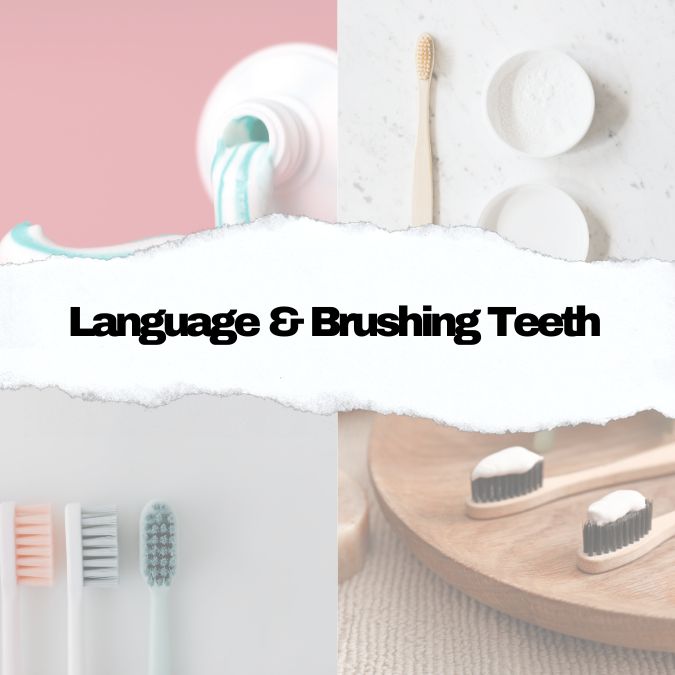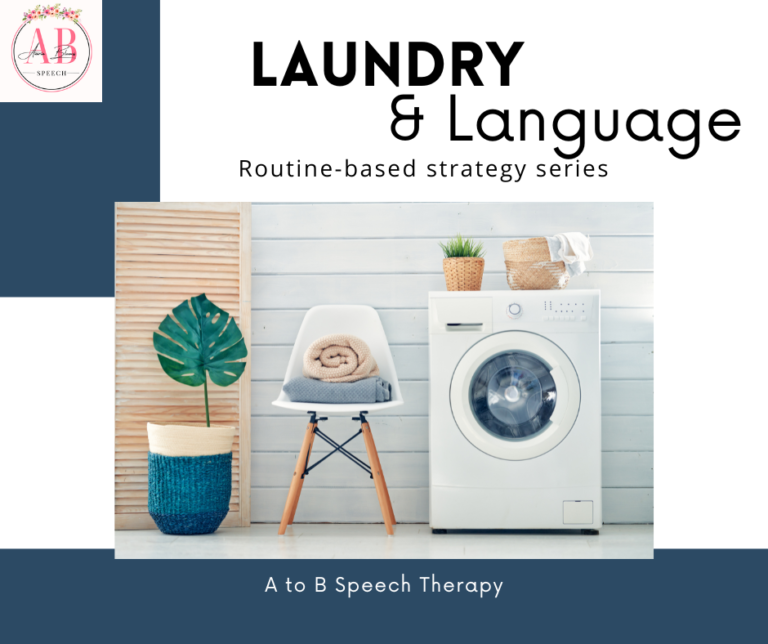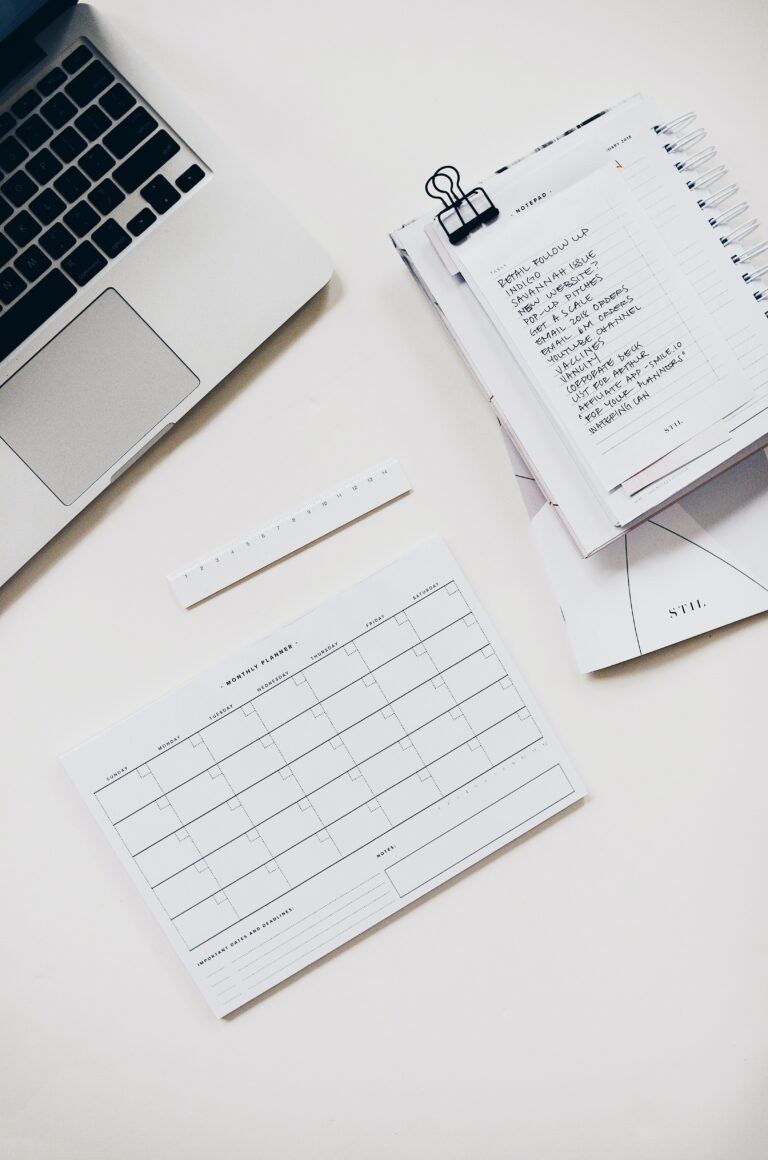In the last few posts, we have talked all about routine-based language learning experiences and why they are so great (hint, they help us to incorporate language strategies and promote language learning for our littles with the things that we are already doing!). One of the most important parts of routine-based language strategies is that routines are generally things that we do repetitively each week, day, or even multiple times per day. If you want to learn more about the benefits of incorporating language strategies into routines as well as what routine-based speech therapy is, check out our first blog post in the series HERE. Let’s dive into some activities that take place at bedtime and talk about how we can incorporate language-learning into daily tasks for a language-boost!
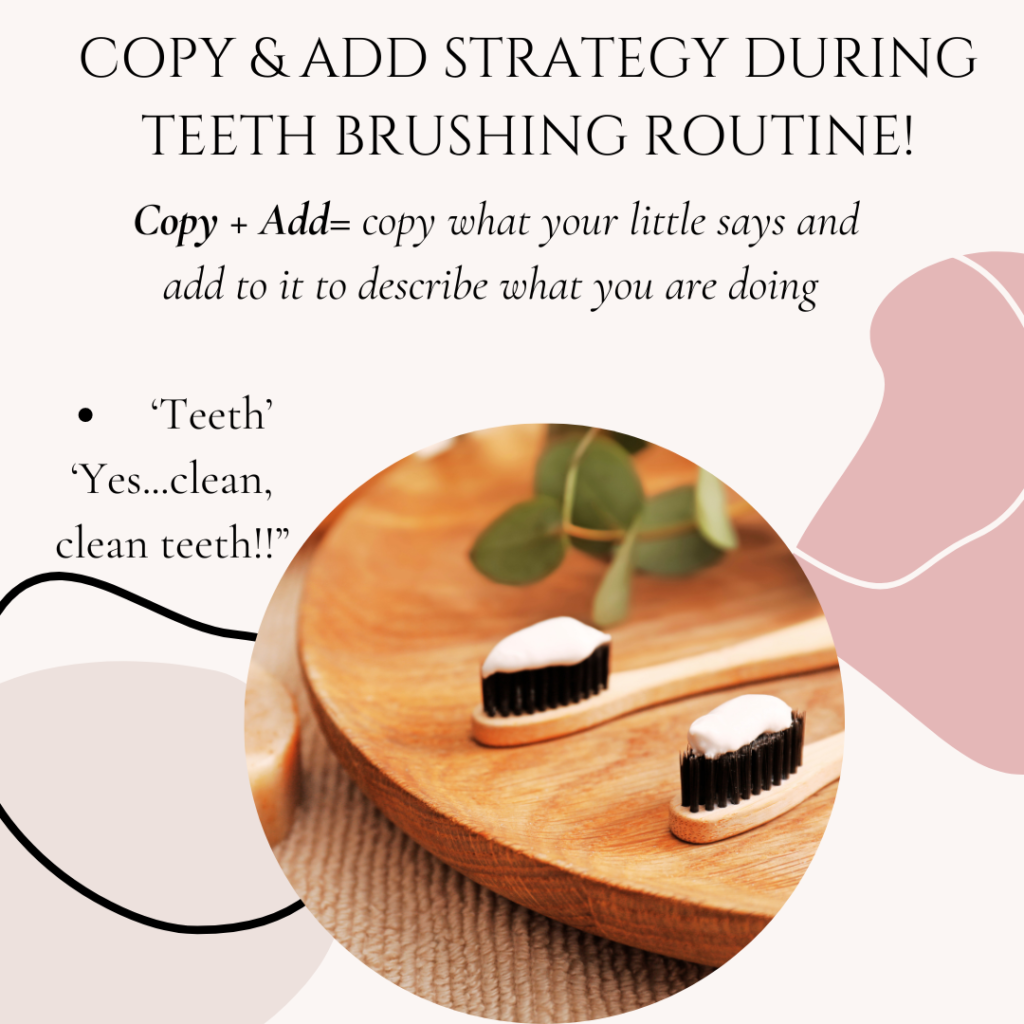
This post may contain affiliate links, this means that we could receive a commission when you click on one of our links and purchase something that was recommended. In some cases, we may be compensated for writing this post. Don’t worry, it is at no extra cost to you and all opinions and recommendations shared are truly our own! See our full policy here
What strategies can I use during ‘teeth brushing’ time?
You can use any of our early-language strategies during teeth brushing routines and adapt them to the activity! We are just going to talk about a few examples today…but remember that any of the strategies that you have learned about can be used!
The ‘big three’
Some activities that we might think of when it comes to bedtime are: reading, brushing our teeth, changing into pajamas, and more! Each one of these activities can be its own separate post, so we are going to focus just on one today- brushing our teeth! When we think about how we can incorporate language into routine-based activities, we want to think about 3 things: nouns, verbs, expansion. Using this simple framework helps us to identify language-rich opportunities. Let’s break it down:
- Nouns: what are the objects/things/places that are in your routine that you can model and talk about with your little? One of the important parts of language development is increasing your little’s vocabulary. Helping them to map the things in their little worlds to a word by purposefully repeating and saying that word when the immediate context is there (e.g., you say ‘oh…toothbrush!’ when you take the toothbrush out of the cabinet). We also want to model these words for our little when their attention is on us- this is another reason why routines can be so helpful! Many times, our little is participating in activities with us during our routine and we can comment on the objects that they are interacting with.
- Verbs: verbs, or action words, are so important for our littles who are trying to build their language knowledge! Knowing different types of words is what helps us combine ideas and ultimately generate endless combinations of words to express different ideas. When our littles are just learning language, it’s important that we are teaching them the actions that go along with the new nouns that they are learning! Similarly to nouns, we want to be modeling these words when the context makes sense and you or your little is performing that action. This helps them to associate the word with the action each time you are modeling that word. Check out our blog post here for a quick visual formula to help you combine words!
- Expansion: This is the third ‘key factor’ that we want to keep in mind when modeling during our routines. We want to try to identify where our little is so that we can meet them at their level of understanding and build off of that. If your little is not yet saying words, we want to be modeling single-words repetitively. If your little is using single words, then we want to be modeling new single words and two-word combinations. You can copy the word your little says and add one meaningful unit/idea to it. When we are expanding, we can think about adding describing words (adverbs, adjectives), concepts like big/small, a lot/a little etc., or adding a noun or action word!
- Child: ‘Eat’ Adult: mommy eat; ‘eat banana’ etc.
- Again, check out the ‘word combination formula’ in our blog post here for more!
- To help us know how to expand, we can think about adding an object feature
- Describe the toothpaste: sticky toothpaste, white toothpaste, ‘it’s gooey’ (some ideas: sticky, white, gooey, smooth etc.)
- Describe the toothbrush: ‘mommy’s toothbrush is big! mommy’s toothbrush is IN the cup’, ‘I see Chase on Johnny’s toothbrush!’ (some ideas: big, small, short, colors, rough/bumpy etc.)
- Child: ‘Eat’ Adult: mommy eat; ‘eat banana’ etc.
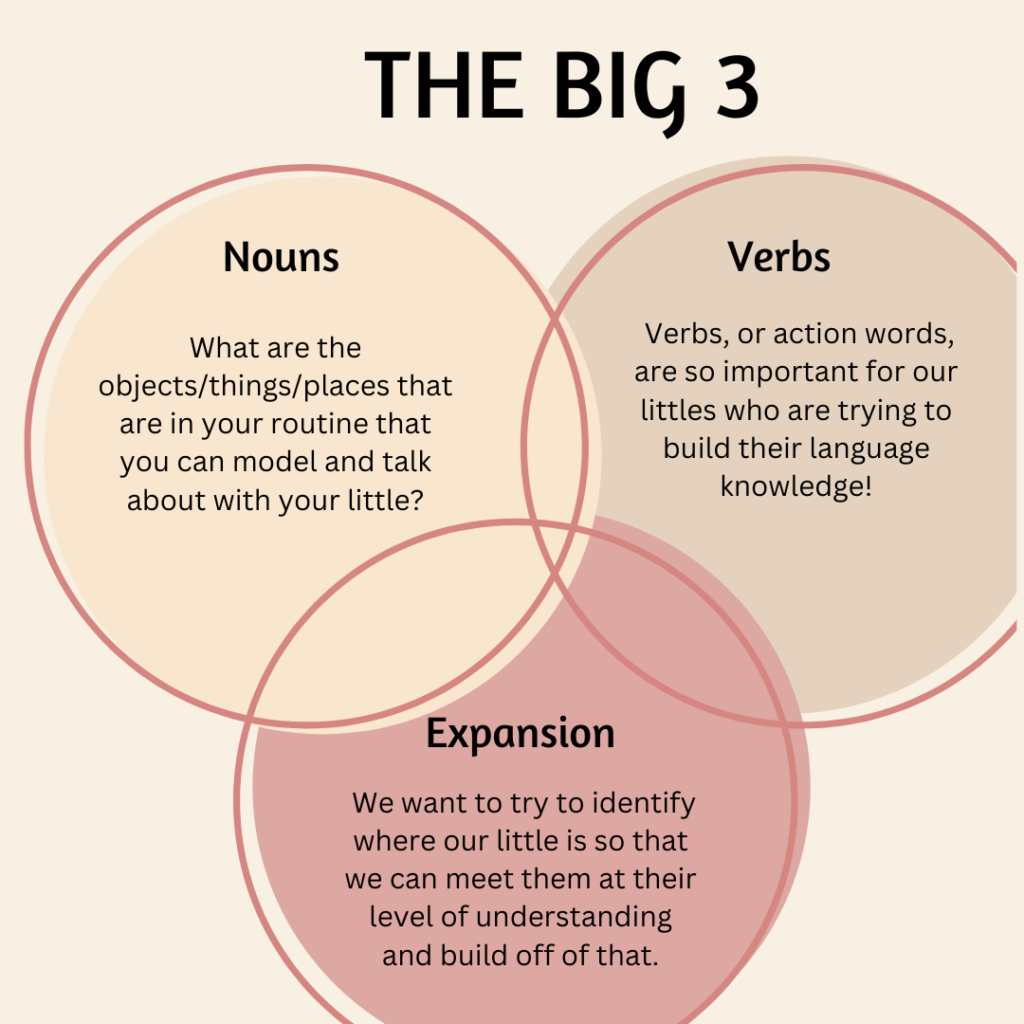
Activity specific language models:
So we have considered the ‘3 biggies’ above and know we want to transfer them into our bedtime/teeth brushing routine. Let’s break this task down by actions and nouns that we can model during this time!
As we are getting ready to brush our teeth:
- Prep your little: ‘time to brush teeth’
- Label: label different objects as you take them out of the cabinet
- Nouns: Toothbrush, toothpaste, mouthwash, water, cup, floss, etc.
- Verbs & Concepts: in, out, brush, swish, spit
- Remember to model these concepts according to your little- if you need help with this, ask a SLP! For example, if your little is already labeling the teeth, we might model: ‘brush, brush teeth’ to teach them the verb and noun to match their understanding and expand what they know
Wrapping up and cleaning up:
Talk about the objects you used as you put them back into the drawer/cabinet
- All done XYZ (all done toothbrush)
- Bye bye XYZ (bye bye toothbrush)
- XYZ + in (toothpaste + in)
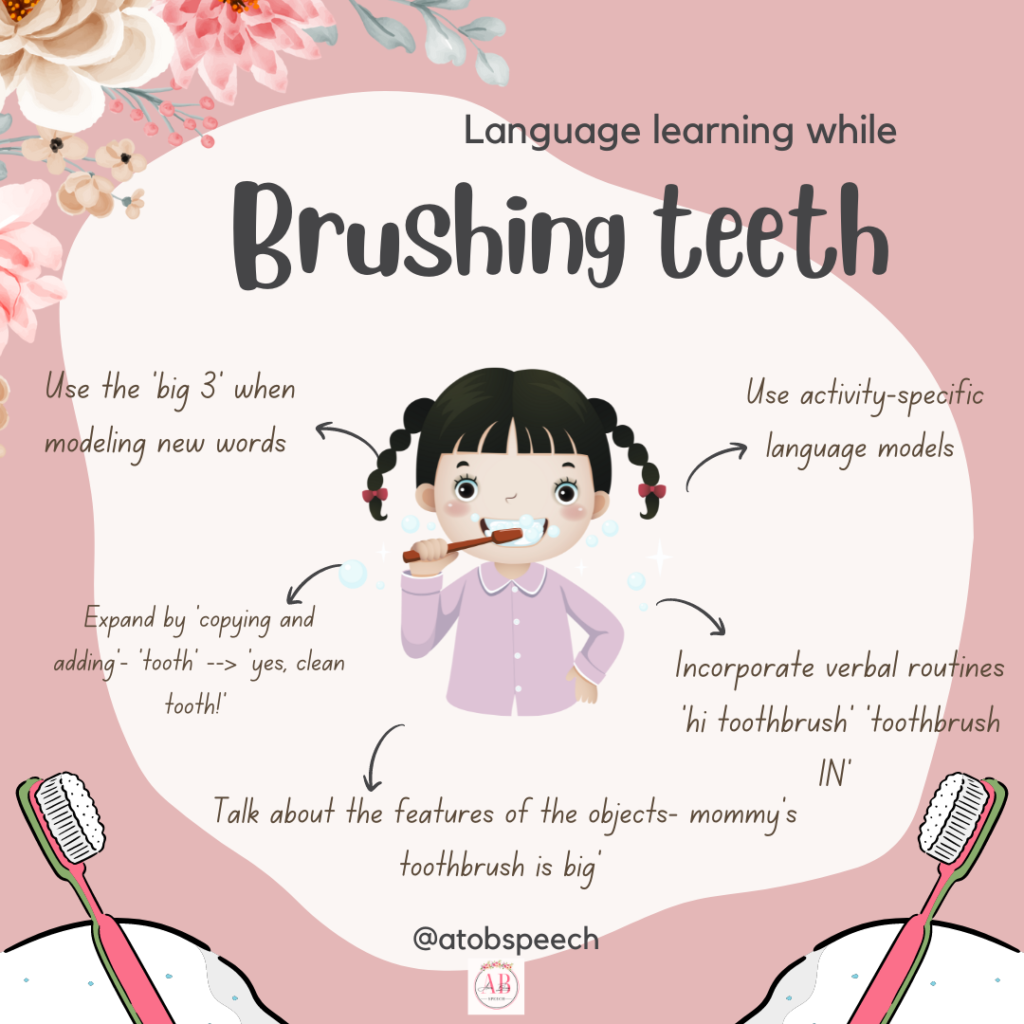
Putting It All Together
As you are getting ready to brush your teeth at night, keep in mind that even something as simple as brushing your teeth at night can truly become a language-learning experience! We want to think about modeling different words and phrases, as well as actions and concepts to help expand the vocabulary ‘banks’ that our littles have. We also want to take a look at what he/she is currently saying and doing and add more! We can expand their ideas by copying their word(s) and adding one more word or idea.
Remember, routines are a perfect place for repetition and the more you can repeat and simplify your language, the better!! As always, please remember that the tips in this blog post are just general language-boosting strategies and do not replace the advice of an SLP- please see your SLP for more individualized tips for the little in your life! See our full disclaimer about this here.

